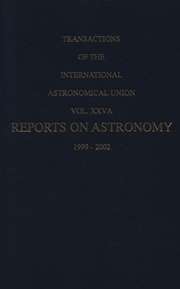No CrossRef data available.
Article contents
2. Anisotropy of the blackbody radiation
Published online by Cambridge University Press: 25 April 2016
Extract
The 2.7 K microwave background radiation provides a sensitive probe of the universe in the interesting, but poorly understood, epoch around z ˜ 1000. At this time (age ~ 10 yr) the universe has cooled to T ~ 4000 K, the plasma combines, Thomson scattering ceases, and matter and blackbody radiation decouple. Subsequently, the radiation freely propagates to us, carrying the imprint of temperature fluctuations on the z ~ 1000 surface. The temperature fluctuations could have been caused by primordial density fluctuations, anisotropy in the expansion of the universe, or inhomogeneity in the initial temperature distribution; the z = 1000 surface we see was not causally connected at the time the radiation was released. Interpretation of the anisotropy measurements is complicated by the possibility that the matter may have been reionized (e.g. by massive stars), so the radiation may have been rescattered, possibly as late as z ~ 7.
- Type
- Research Article
- Information
- Copyright
- Copyright © Reidel 1985


